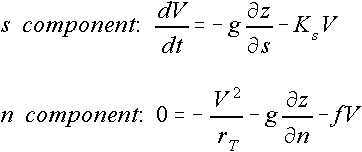
Balanced Atmospheric Flows Tutorial
Flows or winds in the Earth's atmosphere are determined by five particular forces: gravity, pressure gradient, coriolis, friction, and the centrifugal force. These forces are all accounted for in one equation of motion; the momentum equation. Trying to determine the direct effects of all these forces on the wind at any given moment would prove to be a daunting task. Therefore, it is much easier to comprehend the structure of the wind when certain forces are in balance with one another. Hence, a balanced flow is a wind that involves a balance between two or more of the forces described in the momentum equation.
There are some assumtions that are taken into consideration when applying balanced flows. When these flows are analysed, they are assumed to be steady state (time independant). Another assumption is that there is no vertical component to the flow. These assumptions are made so that the balanced flows can be more easily applied to certain applications such as weather maps. When all of these assumptions are taken into account, there are five different balanced flows that become apparent. These are Antitriptic, Cyclostrophic, Geostrophic, Gradient, and Inertial flow.
A large portion of weather maps used today are in isobaric coordinates. Since the momentum equation is typically seen in cartesian coordinates, it is necessary to change it into isobaric coordinates. Furthermore, when applying the momentum equation to the weather map, it is better to use a coordinate system for the momentum equation that is defined along the flow field. This coordinate system is called the natural coordinate system. The combination of these two systems allows for the application of the momentum equation to the weather maps. For example, changing the momentum equation into isobaric coordinates has the effect of changing the pressure gradient term into a more easily applicable term with height as the variable, rather than the pressure.
The momentum equation in isobaric natural coordinates is

| s is the coordinate defined as positive in the direction of the flow field to the right of the n axis | n is the coordinate defined as perpendicular and pointing towards the left of the positive s axis |
| g is the acceleration of gravity at the earth's surface | z is geopotential height |
| Ks is the friction term | rT is the radius of curvature |
| f is the coriolis parameter | V is the wind speed |
| t is time |
 is the tangential acceleration term
is the tangential acceleration term
 is the pressure gradient term in the s equation of motion
is the pressure gradient term in the s equation of motion
 is the friction term
is the friction term
 is the centrifugal acceleration term
is the centrifugal acceleration term
 is the pressure gradient term in the n equation of motion
is the pressure gradient term in the n equation of motion
 is the coriolis term
is the coriolis term
 Next topic: Antitriptic flow
Next topic: Antitriptic flow